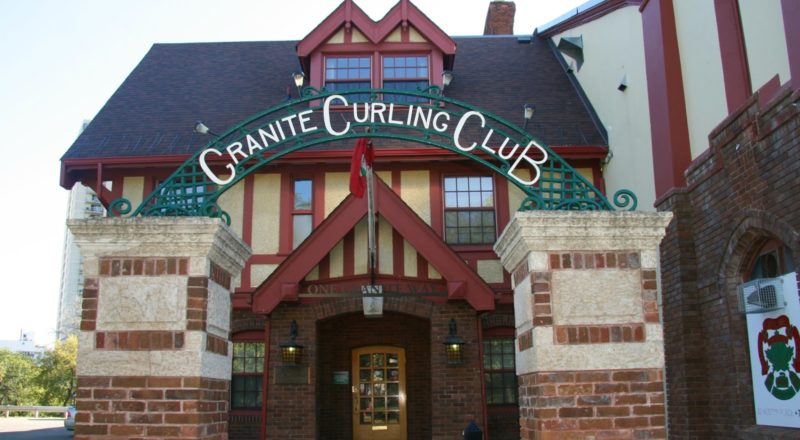
/ Blog
January 29, 2020
The Granite Curling Club: History Between The Sheets
The Granite Curling Clubhouse and Rink at 1 Granite Way is a picturesque building on a shaded lot just off of Osborne Street and has been a mainstay of the Winnipeg curling scene since its opening in 1912. The Granite Curling Club itself, though, is much older. It was founded in 1880, a time before indoor rinks, in Winnipeg and when most curling matches were played on the frozen Red or Assiniboine Rivers.
Curling had been introduced to Manitoba by Scottish settlers sometime around the 1860s, and the game was often played with whatever materials were readily available. At the time, this could mean wood, or stones, but jam-pail curling is a more modern example. For Winnipeg in the 1860s, the material of choice for curling rocks was iron. Foundries surrounding Winnipeg made the manufacturing of iron rocks significantly cheaper than ordering granite rocks, which were produced in Scotland and shipped to Canada.
For a time, bell-shaped iron rocks were the defacto curling equipment in Manitoba but as the sport began to grow in popularity, some began to prefer the use of the more expensive granite rocks. Different leagues had distinctly different preferences, and The Manitoba Curling Club (1876-1883) preferred to use the iron rocks exclusively. They were the first curling club in Manitoba, though they were short-lived.
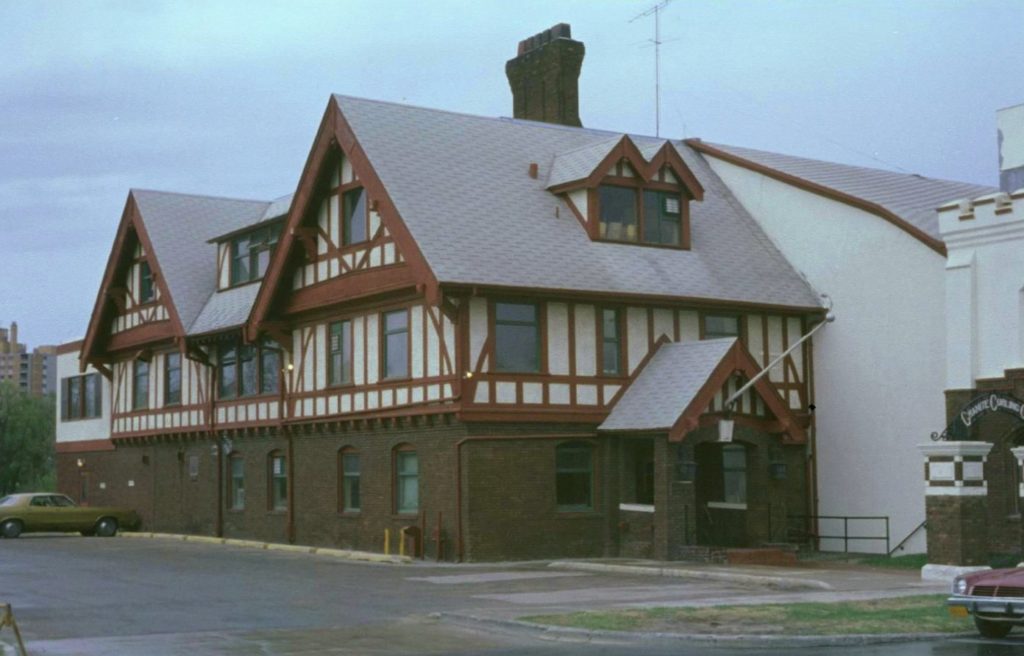
The Granite Curling Club in 1976.
Source: Winnipeg Building Index (University of Manitoba Libraries)
The Granite Curling Club had the exact opposite preference, and tied their club name directly to the type of curling rocks they preferred to use. After their founding in 1880, the Granite Curling Club played their first game in 1881 under a tent on a sheet of ice along Lombard Avenue. For a time they bounced around from rental location to rental location, before constructing their own rink on Hargrave and Ellice in 1892.
By this point, several other curling groups had splintered off from the Granite Curling Club to form their own clubs (The Thistle and the Assiniboine), earning the Granite the nickname “The Mother Club”. All the while, the Granite Curling Club enjoyed great success. Most of its members, according to club rosters in 1900, were Scottish or Anglo-Saxon and largely among Winnipeg’s upper crust. By 1911, the Granite’s board opted to sell their Hargrave location (which was perfectly functional) and build a more modern and grander rink.
A 400-foot section of land along the Assiniboine, then called Mostyn Place, was purchased in 1911. It was, in many ways, the ideal location for the Granite Curling Club. Water from the river could be pumped into the clubhouse, filtered, and used to create the rink’s ice. At the time, too, the landscape around the Manitoba Legislature was radically different. Between the grand Amphitheatre, stables, and the Winnipeg Stadium, the area was an early iteration of a sports complex and the Granite Curling Club fit right in.
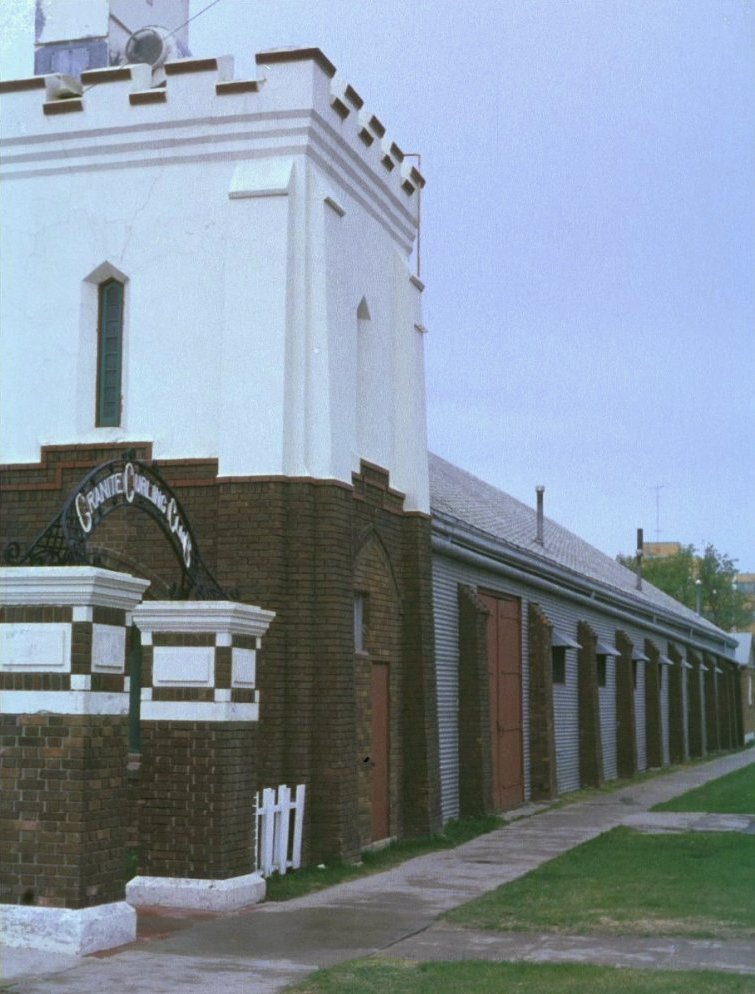
The Granite Curling Club in 1976.
Source: Winnipeg Building Index (University of Manitoba Libraries)
Both the contractor and architect of the new clubhouse were active members. Architect James Chisholm had served as a member of the club’s executive for many years, and paid particular attention to the Granite Clubhouse’s design. Later in life, Chisholm would help found the Strathcona Curling Club and was an honorary member of the Manitoba Curling Association.
Contractor Thomas Kelly was similarly involved in the club, though his reputation today is not as civic-minded as Chisholm. At the time of the Granite clubhouse’s construction, the Legislative Building Construction Scandal that would result in Kelly’s arrest had yet to begin, and Kelly was largely regarded as a prominent contractor and socialite. He was also the skip of a team at the Granite Curling Club.
On the whole, the clubhouse’s design was meant to give off a “home-like” atmosphere. Tudor-style half timbering covers rough cast stucco on the upper floors of the facade, while the main floor is faced in deep brown brickwork. Welcoming prospective curlers and spectators is a front entrance, which Chisholm paid special attention to in his design. Oversized pillars support an iron wrought arch inscribed with “Granite Curling Club”, and behind this is the gabled porch lit by carriage lanterns.
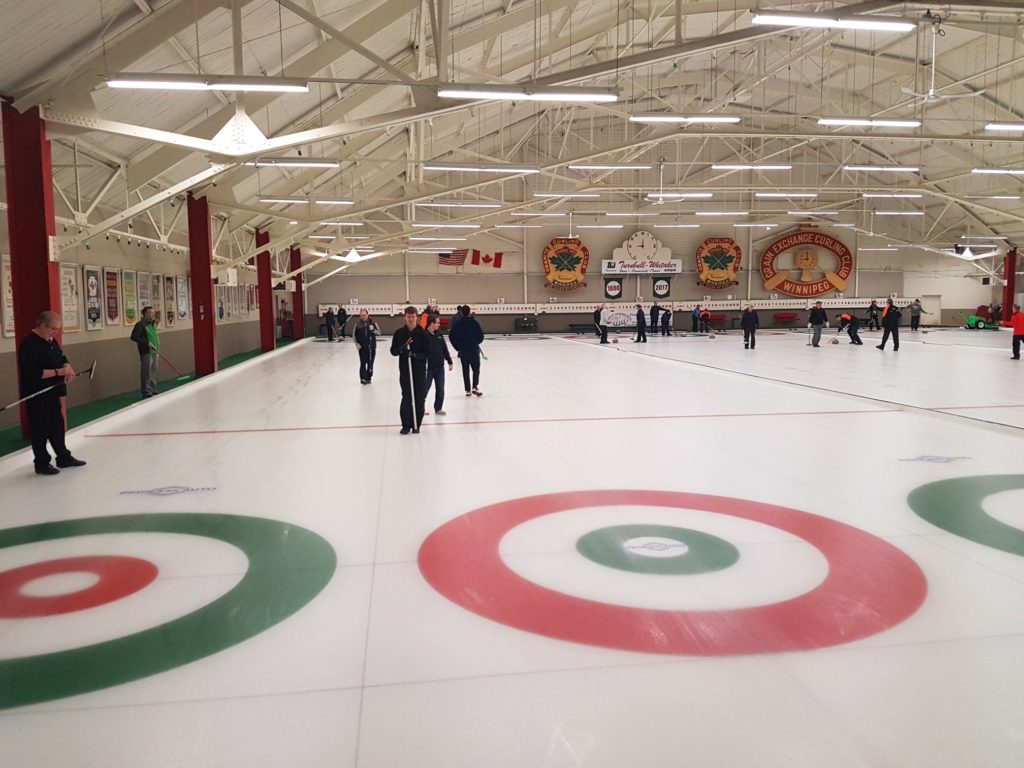
Inside the Granite Curling Club in January 2017.
Source: Krazytea (CC BY-SA 4.0, via Wikimedia Commons)
Inside, the atmosphere was similarly cozy. The heart of the clubhouse was and is the dining room, where the ceiling beams resemble those of an English cottage and the walls are lined in rich oak paneling. At the center of the room is a massive brick fireplace, with a bronze plaque above the mantel detailing the early history of the club. Today, trophy cases frame either side of the fireplace. Though interior changes have been made over the years to modernize the club, including the construction of a two-storey kitchen and bar in 1959, the comfortable atmosphere remains very much the same.
These elaborate details did not come cheap. Construction cost somewhere around $140,000 in 1913 (or nearly $3 million today). It also caused significant delays, and the project didn’t open for over a year after construction began in 1911. This didn’t slow the Granite Curling Club down much, as they constructed a temporary rink to use until the new clubhouse could open. Still, the delays were a regular topic of conversation. The icemaker for the club, Dan McNeil, “bet a few cigars, also several other things, that he would be ready before December 15th” (Free Press, December 7th, 1912).
McNeil won that bet. The Granite Curling Club officially opened on December 7th 1912, with nine sheets of ice ready for play. The project was highly anticipated and the building highly regarded. In fact, when the clubhouse opened guests arrived from across the province to participate in the formal opening ceremonies on January 8th, 1914. These “members of the curling fraternity”, as the Winnipeg Free Press called them, came from Minnesota, Emerson, and even Duluth, Minnesota and participated in a variety of curling matches in the new rink, and enjoyed dinner in the clubhouse’s dining room.
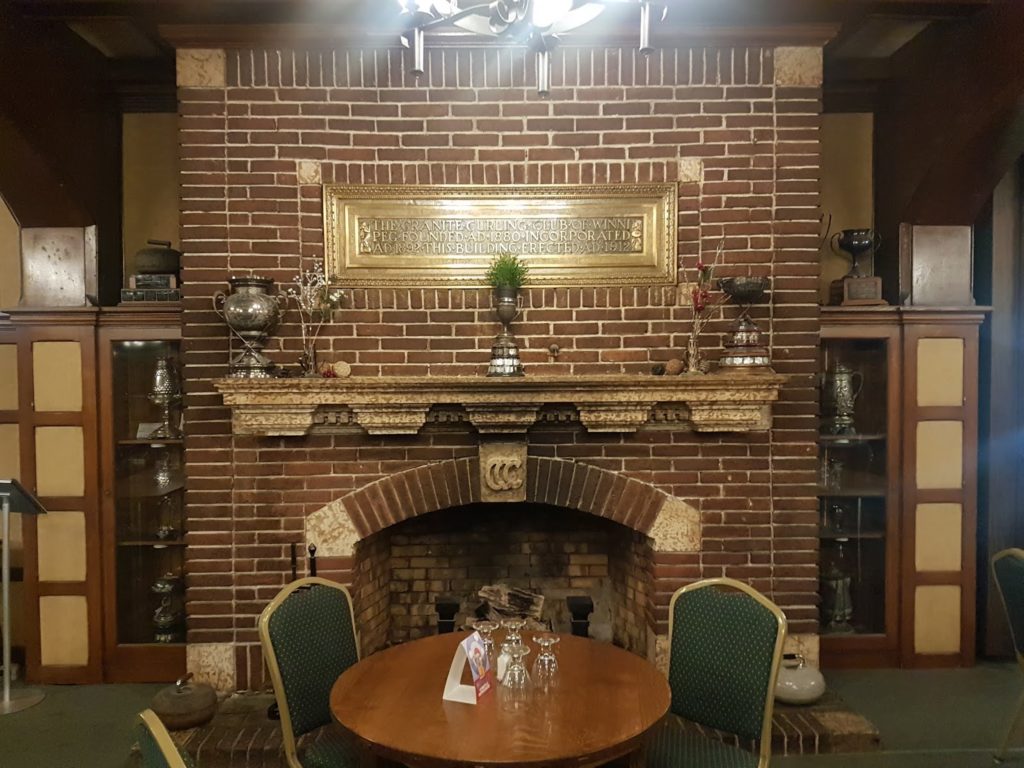
The central fireplace in the dining room of the Granite Curling Club.
Source: Heritage Winnipeg (Sabrina Janke)
The new rink was a talking point in and of itself. In the days before artificial ice, only a layer of sand separated the ground from the rink’s ice and the wooden walls were far from airtight. Supporting the arched roof are trusses that are lined with multi-coloured lights. Wooden platforms surround the ice to allow viewing from all angles, and there are windows for spectators on the first and second floor of the clubhouse.
In 1953, the Granite became the first rink in Manitoba to use artificial ice. This required significant alterations to the ground beneath the rink, and the installation of heavy machinery to control temperature and maintain the ice’s surface.
For much of the first half of the 20th century, the grounds surrounding the Granite were a hub of activity; a campsite operated on the grounds near the clubhouse for decades and was remarkably popular. In 1938, the camp grounds saw over 200 guests (largely American) pass through on summer road trips. Cabins opened up on the same lot sometime in the 1950s, promising a “A home away from home” (Winnipeg Tribune, 1951-09-24 (22)) though these were sold by 1965.
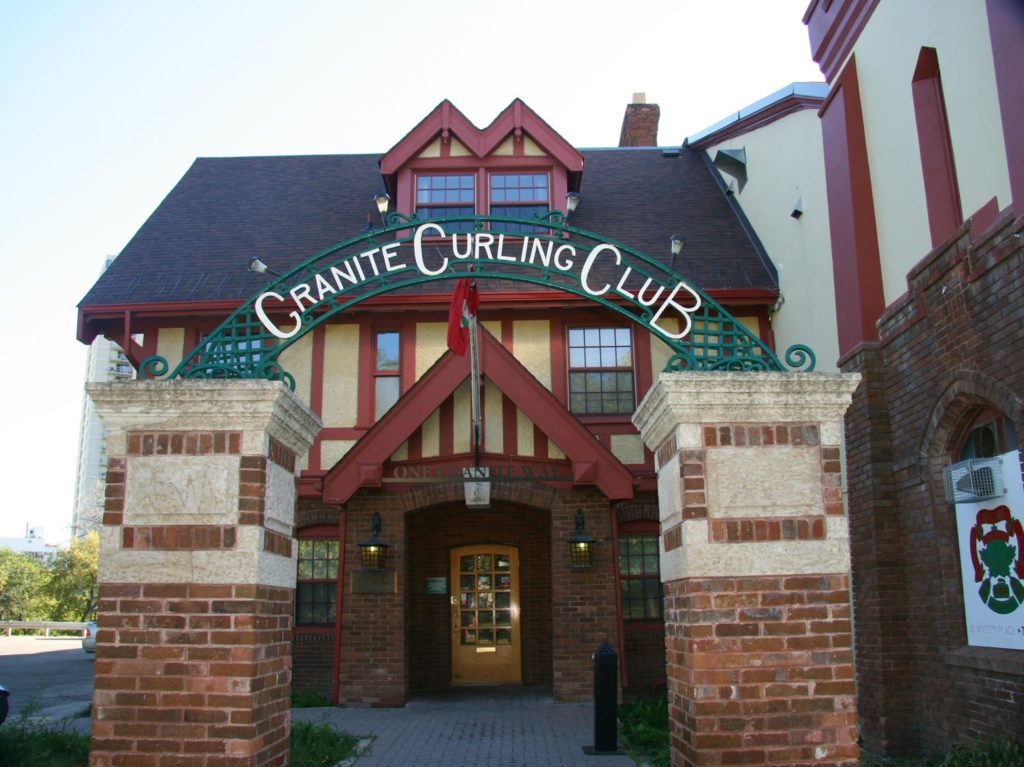
The Granite Curling Club entrance in September 2013 ,
Source: Samyaka.verma (CC BY-SA 3.0, via Wikimedia Commons)
Though the popularity of the sport did not wane, the Granite Curling Club still faced times of trouble. After overspending on construction in 1912, the Province of Manitoba purchased the clubhouse and rink in 1916 and rented it back to the Granite Curling Club. The Granite purchased it back in 1946, but after a financial squeeze in 1976 they opted to sell the building to the City of Winnipeg for a cash settlement and a satisfactory lease-back agreement. On September 29th, 1986, the City of Winnipeg designated the Granite Curling Club as a municipal heritage building.
Across 135 years of operation, the Granite Curling Club has maintained a special place in the curling world and many reputable curlers have passed through the club’s doors. The winners of the 1970 and 1971 World Curling Championship were all lifetime members of the Granite Curling Club. Teams from the Granite had won the MacDonald Provincial Bonspiel so many times that when the trophy was retired, the Granite was able to keep and display it.
More recently, the Granite Curling Club made the news thanks to a celebrity visit. In February 2019, Justin Timberlake rented out the dining room of the clubhouse to watch the Superbowl while he was in town on tour.
The Granite Curling Club remains as picturesque as ever, and today has over fifteen leagues playing every week. It is also the oldest curling club in Western Canada, still hurrying hard and promoting curling excellence across the province!
THANK YOU TO THE SPONSOR OF THIS BLOG POST:

Written by Heritage Winnipeg.
SOURCES:
135 Years of Curling | Granite Curling Club
Bonspiel! The History of Curling in Canada | Library & Archives Canada
Formal Opening of Granite Rink is Unique Ceremony | Manitoba Free Press - January 9, 1914, page 5
TimeLinks: Legislature Scandal | Manitoba Historical Society - March 15, 2019





